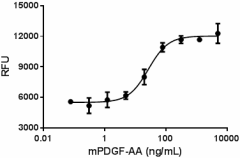- Regulatory Status
- RUO
- Other Names
- Platelet-Derived Growth Factor-AA, Glioma-derived growth factor (GDGF), Osteosarcoma-derived Growth Factor (ODGF)

-

Mouse PDGF-AA induces proliferation of NIH3T3 mouse embryonic fibroblast cells in a dose dependent manner with ED50 of 15 - 60 ng/mL. -

Stability testing for mouse PDGF-AA. Mouse PDGF-AA was aliquoted in 4 mM HCl at 0.2 mg/mL. One aliquot was frozen and thawed four times (4x freeze/thaws), and compared to a control kept at 4°C (control). The samples were tested in NIH3T3 mouse embryonic fibroblast cell proliferation assay.
| Cat # | Size | Price | Quantity Check Availability | ||
|---|---|---|---|---|---|
| 776302 | 10 µg | $147.00 | |||
| 776304 | 25 µg | $265.00 | |||
| 776306 | 100 µg | $844.00 | |||
| 776308 | 500 µg | $2109.00 | |||
Platelet-derived growth factors (PDGFs) are homo- or heterodimers of four polypeptides, known as A, B, C and D chains. PDGFs usually act primarily in paracrine manner and may be engaged in autocrine loops in tumors. Five PDGF isoforms (AA, BB, AB, CC and DD) have been identified. PDGFs are primarily synthesized, stored, and released by platelets upon activation. PDGF-A and PDGF-B undergo intracellular activation during transport in the exocytic pathway and PDGF-C and PDGF-B are activated by extracellular proteases. Like PDGF-B, intracellular activation of PDGF-A, by removing the N-terminal sequence, is required for PDGF-A to bind to its receptor. PDGF-A can also be expressed by epithelial cells, smooth muscle cells, and neuronal progenitors. PDGF-AA is well known as a potent mitogen for the proliferation of oligodendrocyte progenitor cells (OPCs). PDGF-AA can promote embryonic forebrain neural stem cells into O4-positive oligodendrocytes by activating Erk pathway. PDGF-AA also plays an important role in directing cell migration during embryonic development and postnatal migration response including wound healing. Chemotaxis abilty of PDGF-AA has been shown on fibroblasts, smooth muscle cells, monocytes, and granulocytes.
Product Details
- Source
- Mouse PDGF-AA, amino acids Ser87-Thr211 (Accession# P20033.2), was expressed in E. coli.
- Molecular Mass
- The 125 amino acid recombinant protein has a predicted molecular mass of approximately 14 kD. The DTT-reduced and non-reduced protein migrates at approximately 15 and 31 kD respectively by SDS-PAGE. The predicted N-terminal amino acid is Ser.
- Purity
- > 95%, as determined by Coomassie stained SDS-PAGE.
- Formulation
- 0.22 µm filtered protein solution is in 4mM HCl.
- Endotoxin Level
- Less than 0.1 EU per µg cytokine as determined by the LAL method.
- Concentration
- 10 and 25 µg sizes are bottled at 200 µg/mL. 100 µg size and larger sizes are lot-specific and bottled at the concentration indicated on the vial. To obtain lot-specific concentration and expiration, please enter the lot number in our Certificate of Analysis online tool.
- Storage & Handling
- Unopened vial can be stored between 2°C and 8°C for up to 2 weeks, at -20°C for up to six months, or at -70°C or colder until the expiration date. For maximum results, quick spin vial prior to opening. The protein can be aliquoted and stored at -20°C or colder. Stock solutions can also be prepared at 50 - 100 µg/mL in appropriate sterile buffer, carrier protein such as 0.2 - 1% BSA or HSA can be added when preparing the stock solution. Aliquots can be stored between 2°C and 8°C for up to one week and stored at -20°C or colder for up to 3 months. Avoid repeated freeze/thaw cycles.
- Activity
- ED50 = 15 - 60 ng/mL as measured by the ability of protein to induce proliferation of NIH3T3 mouse embryonic fibroblast cells. Deep Blue Cell Vialibity Kit (Cat. No. 424702) was used to quantitate cell proliferation.
- Application
-
Bioassay
- Application Notes
-
BioLegend carrier-free recombinant proteins provided in liquid format are shipped on blue ice. Our comparison testing data indicates that when handled and stored as recommended, the liquid format has equal or better stability and shelf-life compared to commercially available lyophilized proteins after reconstitution. Our liquid proteins are verified in-house to maintain activity after shipping on blue ice and are backed by our 100% satisfaction guarantee. If you have any concerns, contact us at tech@biolegend.com.
- Product Citations
-
Antigen Details
- Structure
- Homodimer
- Distribution
-
Platelets produce PDGF-AA. Other cells, including epithelial cells, smooth muscle cells, and neuronal progenitors, can also produce PDGF-AA.
- Function
- PDGF-A has two isoforms due to alternative splicing which is cell type-specific and is different among organs and tumor cell lines. Expression of PDGF-A can be increased in human uterine smooth muscle cells during the physiological hypertrophy. Expression of PDGF-A can be repressed by glucocorticoid treatment of smooth muscle cells and aging of human fibroblasts.
- Interaction
- Smooth muscle cells, connective tissue cells, bone and cartilage cells, and oligodendrocyte cells.
- Ligand/Receptor
- PDGFR-αα
- Bioactivity
- Measured by the ability of protein to induce proliferation of NIH3T3 mouse embryonic fibroblast cells.
- Cell Type
- Hematopoietic stem and progenitors, Mesenchymal Stem Cells, Neural Stem Cells
- Biology Area
- Angiogenesis, Cell Biology, Immunology, Neuroscience, Neuroscience Cell Markers, Stem Cells
- Molecular Family
- Cytokines/Chemokines, Growth Factors
- Gene ID
- 18590 View all products for this Gene ID
- UniProt
- View information about PDGF-AA on UniProt.org
